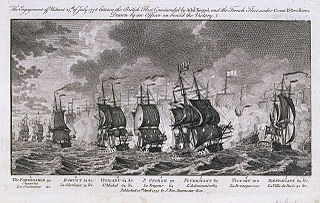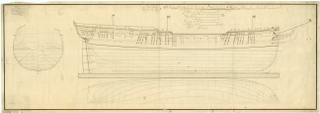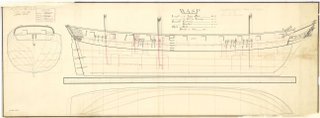
HMS Minotaur was a 74-gun third-rate ship of the line of the Royal Navy launched on 6 November 1793 at Woolwich. She was named after the mythological bull-headed monster of Crete. She fought in three major battles – Nile, Trafalgar, and Copenhagen (1807) – before she was wrecked, with heavy loss of life, in December 1810.

HMS Thetis was a 38-gun fifth-rate frigate of the Royal Navy launched in 1782.

Tigre was a 74-gun ship of the line of the French Navy. Later it was captured by the British and, as HMS Tigre, operated as part of the Royal Navy throughout the Napoleonic Wars.

HMS Northumberland was a 74-gun third-rate ship of the line of the Royal Navy, built at the yards of Barnard, Deptford and launched on 2 February 1798. She carried Napoleon to his final exile on St Helena.

HMS London was a 90-gun second-rate ship of the line of the Royal Navy, launched on 24 May 1766 at Chatham Dockyard.

HMS Robust was a 74-gun third-rate ship of the line of the Royal Navy, built by John Barnard and launched on 25 October 1764 at Harwich. She was the first vessel of the Royal Navy to bear the name.
HMS Dictator was a 64-gun third-rate ship of the line of the Royal Navy, launched on 6 January 1783 at Limehouse. She was converted into a troopship in 1798, and broken up in 1817.
HMS Kent was a 74-gun third-rate ship of the line of the Royal Navy, launched on 17 January 1798 at Blackwall Yard.
HMS Spencer was a 74-gun third-rate ship of the line of the Royal Navy, launched on 10 May 1800 at Bucklers Hard. Her designer was the French émigré shipwright Jean-Louis Barrallier. She served in two major battles, Algeciras Bay and San Domingo, and in a number of other campaigns. She was broken up in 1822.

America was a Téméraire-class 74-gun ship of the line of the French Navy. The Royal Navy captured her in 1794 at the Battle of the Glorious First of June. She then served with the British under the name HMS Impetueux until she was broken up in 1813. She became the prototype for the Royal Navy America-class ship of the line.

HMS Cerberus was a 32-gun fifth-rate frigate of the Royal Navy. She served in the French Revolutionary and the Napoleonic Wars in the Channel, the Mediterranean, the Adriatic, and even briefly in the Baltic against the Russians. She participated in one boat action that won for her crew a clasp to the Naval General Service Medal (NGSM). She also captured many privateers and merchant vessels. Her biggest battle was the Battle of Lissa, which won for her crew another clasp to the NGSM. She was sold in 1814.
HMS Chichester was a 70-gun third rate ship of the line of the Royal Navy, designed by Sir Joseph Allin and built by Peirson Lock at Portsmouth Dockyard to the standard draught for 70-gun ships as specified in the 1745 Establishment amended in 1750, and launched on 4 June 1753.

HMS Amethyst was a Royal Navy 36-gun Penelope-class fifth-rate frigate, launched in 1799 at Deptford. Amethyst served in the French Revolutionary Wars and the Napoleonic Wars, capturing several prizes. She also participated in two boat actions and two ship actions that won her crew clasps to the Naval General Service Medal. She was broken up in 1811 after suffering severe damage in a storm.

HMS Dido was one of the twenty-seven Enterprise class of 28-gun sixth-rate frigates in service with the Royal Navy during the late eighteenth and early nineteenth centuries. Dido was commissioned in September 1787 under the command of Captain Charles Sandys. She participated in a notable action for which her crew would later be awarded the Naval General Service Medal; her participation in a campaign resulted in the award of another. Dido was sold for breaking up in 1817.

HMS Wasp was an 18-gun sloop of the British Royal Navy. She was formerly the French naval brig Guêpe, which the Navy captured in 1800. She served during the French Revolutionary and Napoleonic Wars, and was sold out of naval service in 1811.
HMS Cynthia was a ship sloop of unusual design, launched in 1796. She took part in one medal-worthy boat action and participated in captures of a number of merchant vessels, was present at two notable occasions, the surrender of the Dutch fleet in the Vlieter Incident and the capture of Alexandria, and her crew participated in two land attacks on forts. She was broken up in 1809.
His Majesty's hired armed cutter Ann served the British Royal Navy from 9 May 1795 to 19 October 1801 during the French Revolutionary Wars. She was of 10491⁄94 tons (bm) and carried twelve 3-pounder guns.
His Majesty's hired armed cutter Courier appears twice in the records of the British Royal Navy. The size and armament suggests that both contracts could represent the same vessel, but other information indicates that the second Courier had been captured from the French in the West Indies. On the first contract the captain and crew were awarded clasps to the Naval General Service Medal, one for a boat action and one for a single ship action in which they distinguished themselves.

HMS Greyhound was a cutter that the British Admiralty purchased in 1780 and renamed Viper in 1781. Viper captured several French privateers in the waters around Great Britain, and took part in a notable engagement. She was sold in October 1809.
Mutin was a 14-gun cutter of the French Navy, the lead ship of the Mutin class of five naval cutters. She was launched in 1778 and the Royal Navy captured her the next year, taking her into service as HMS Mutine. The Royal Navy renamed her HMS Pigmy in 1798. She was lost in 1805.












